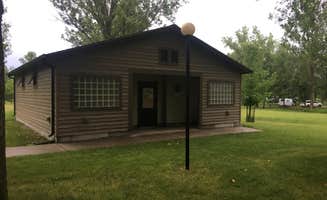Fort Ransom State Park provides the largest concentration of cabin accommodations in the Valley City area. Situated in the Sheyenne River Valley, these cabins lie within 25-30 miles of Valley City in terrain characterized by river valleys, prairie grasslands, and wooded areas. Winter temperatures in the region often drop below zero, while summer highs typically reach the 80s, making cabin camping particularly appealing during spring and fall seasons when outdoor activities remain comfortable but tent camping might be challenging.
What to do
Hiking and biking trails: Fort Ransom State Park offers nearly 20 miles of trails through diverse terrain. "There are miles of trails through all kinds of habitats from forest to prairie to riparian shores and the water trail," notes camper Janet R. Trail difficulty ranges from easy walking paths to more challenging routes suitable for mountain biking.
Winter recreation options: Several cabin facilities remain open year-round with Fort Ransom offering winter sports during snow season. "In winter there is great cross country skiing and snowshoeing and summer of course has camping, canoeing, hiking, and nature watching," according to one reviewer. Winter cabin stays typically require advance booking at least 2-3 months ahead.
Historical education: Learn about pioneer history through preserved sites and exhibits. "Very green park with a lot of history, including a preserved farm about early white settlers," mentions Lynn G. Educational programs run primarily May through September with special events like Sodbuster Days highlighting regional agricultural heritage.
What campers like
River access for paddling: The Sheyenne River provides paddling opportunities with equipment rentals available at some locations. "We really wished we had rented a canoe or kayak (from the park) but it was a holiday weekend so they were all gone by the time we sauntered out of the tent near noon," shares one Fort Ransom visitor. Weekend rentals cost approximately $25-35 per day.
Spacious tent sites near cabins: Jamestown Campground offers open camping areas with good spacing. "So beautiful, open and wonderful camping sites with shade, tables, fire pits and sunset views. I came in the peak of the Summer on a saturday and had plenty of space and privacy," writes Lila F. Sites near cabins allow for mixed group accommodations.
Well-maintained facilities: Campgrounds maintain clean bathrooms and shower facilities. "Clean bathrooms and showers, really nice staff," notes one camper about Jamestown facilities. Most cabin areas feature modern restrooms within walking distance, though some primitive cabins require longer walks to bathroom facilities.
What you should know
Weather considerations: Strong winds can affect open camping areas, while cabins provide better protection. "Only down side was that you got to feel the ND winds (10-30mph+) all the time," reports a Fort Ransom camper. Primitive cabins may lack climate control, so portable fans or heaters are recommended depending on season.
Reservation timing: Jamestown Dam/Lakeside Marina Campground requires booking well in advance during peak season. "Book early as it is a popular area," advises Ken D., adding that for extended stays, "You will have to change sites every 14 days if you are going to be staying a long time." Most cabin facilities follow similar 14-day maximum stay policies.
Varying amenity levels: Cabin facilities range from basic structures to fully equipped units. "Lots of shade trees. It is not technically 'lakeside' but about a half mile walk across the highway to get to the lake," notes Stacy M. about Jamestown Dam facilities. Many cabins lack cooking facilities beyond outdoor fire rings, requiring campers to bring camp stoves.
Tips for camping with families
Playground access: Pelican Point Landing offers family-friendly amenities near cabin sites. "Nice little bar/restaurant on site with free wifi. Basically no cell service. Decent swimming with boat landing. Small playground for kids," reports Mason. Most playgrounds remain open from dawn until 10 pm.
Educational programming: Park staff at several locations provide child-friendly activities and nature programs. "The camp staff were especially great with lots of stories to entertain the preschooler and grandma!" shares one Fort Ransom visitor. Programs typically run during summer months and often require no additional fees.
Swimming options: Several locations offer swimming access with varying facilities. "Swimming (not the best swimming ever)," notes one Pelican Point Landing review, suggesting families bring water toys or flotation devices. Most swimming areas lack lifeguards and operate under swim-at-your-own-risk policies.
Tips from RVers
Site leveling challenges: Binford Park Campground and other locations may present leveling difficulties. "The ground was far from level, we managed," reports an RVer at Pelican Point Landing. Cabin stays eliminate this concern but often lack RV hookups for those traveling with both accommodations.
Campground access roads: Some locations feature unpaved access roads that may become problematic in wet conditions. "It was raining when we arrived so access road muddy! They added some sand on areas and we had 4 wheel drive!" shares Pat M. about Jamestown Campground. Most cabin areas remain accessible year-round, though winter access may require snow removal.
Cell service limitations: Connectivity varies significantly between cabin locations. "Basically no cell service," notes a Pelican Point Landing reviewer, while "Wifi was really fast" at other locations according to Tina's Jamestown Campground review. Several cabin areas offer WiFi at central facilities like visitor centers rather than at individual sites.


